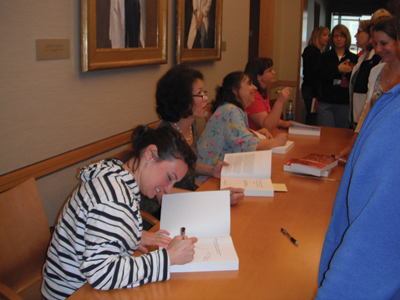Four Nurse Narratives Featured in New Book

During a book-signing event at BWH, Andrea Edmands autographs a copy.
Corinne Cyr Pryor, BA, RNC, IBCLC, just knew that the father of one of her tiny patients in the NICU longed to hold his son. Yet, every time she asked, he declined. “I knew he was scared,” Cyr Pryor said. “But one day, I decided that he would hold his son that day. Before he could do anything, I put the baby in his arms, right on his chest.”
The father “melted,” she said, and after that day, he wanted to hold his son every day.
The narrative she wrote about this experience is one of four powerful narratives by BWH nurses featured in a new book, “Clinical Wisdom and Interventions in Acute and Critical Care,” by Patricia Benner, PhD, RN, FAAN, Patricia Hooper Kyriakidis, PhD, MSN, and Daphne Stannard, PhD, RN, CCRN, published this spring.
Hooper-Kyriakidis has been working with members of the BWH Nursing Practice Committee as part of a qualitative study to “Define the Good” in nursing practice at BWH. As part of the committee’s work to “Preserve and Extend the Good,” each member shared a narrative about their own practice so that the characteristics of excellent nursing practice at BWH could be identified. In addition to Cyr Pryor, the narratives written by Beth Baldwin, BSN, RN, nurse educator, MaryAnne Bennett, BSN, RN, of the NICU, and Andrea Edmands, RN, of the Burn/Trauma ICU, were also published.
“Pat has been working with us on the committee to define excellence in nursing practice at BWH and extend it throughout the hospital,” Cyr Pryor said. “Participating on this committee is a wonderful experience, and I know we are going to make a difference in nursing practice at BWH.”
Having her narrative published and participating in a special book-signing event at BWH in May was also a memorable experience, she said.
“It’s a great honor to have my narrative published,” she said. “I hope when people read it, they are reminded about the fact that knowing your patient is one of the most important things. Because I knew my patient and his family, I knew what the right thing to do was, and it made a difference.”
Baldwin, nurse educator for Patient and Family Education, agreed. “Connecting with your patient can take place in many ways,” she said. “By knowing your patient, you understand how to help fulfill their wishes and meet their needs.”

Baldwin’s narrative reflects on an experience she had as a staff nurse caring for a patient with do-not-resuscitate orders on Tower 14AB. The patient’s breathing became slow after her husband went home one night, and though she still did not want to be resuscitated, she also wanted her husband to be with her when she passed away. Baldwin understood and stayed after her shift at her patient’s bedside, stimulating her and essentially helping her to stay alive until her husband returned to hold her hand.
“Because I knew her wishes, I understood my role—and the rest of the care team’s role—in helping to fulfill them,” Baldwin said. “Earlier on in her care, I had asked her if she was scared about dying. I took a risk in asking a tough question, but it opened up an important conversation between us.”
Baldwin hopes the readers of this book will take that message to heart, to know their patients and ask questions to understand them better. “It can be so powerful in your practice,” she said.